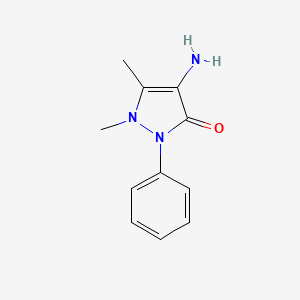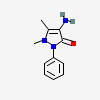4-Aminoantipyrine
- 4-Aminoantipyrine
- AMPYRONE
- 83-07-8
- 4-Aminophenazone
- Metapirazone
- Create:2005-03-25
- Modify:2025-01-18
 Aminopyrine (annotation moved to).
Aminopyrine (annotation moved to).
- 4 Amino 1,5 Dimethyl 2 Phenyl 3H Pyrazolone
- 4 Aminoantipyrine
- 4 Aminophenazone
- 4-Amino-1,5-Dimethyl-2-Phenyl-3H-Pyrazolone
- 4-Aminoantipyrine
- 4-Aminophenazone
- Aminoantipyrine
- Ampyrone
- 4-Aminoantipyrine
- AMPYRONE
- 83-07-8
- 4-Aminophenazone
- Metapirazone
- Aminoantipyrine
- 4-Aminoantipyrene
- Solvapyrin-A
- Aminoantipyrin
- Aminoazophene
- Solnapyrin-A
- Aminoazophenazone
- 4-AAP
- 4-Amino-2,3-dimethyl-1-phenyl-3-pyrazolin-5-one
- 3H-Pyrazol-3-one, 4-amino-1,2-dihydro-1,5-dimethyl-2-phenyl-
- Antipyrine, 4-amino-
- 4-Amminoantipirina
- 4-Amminoantipirina [Italian]
- MFCD00003145
- NSC 60242
- 4-Amino-1,5-dimethyl-2-phenyl-1,2-dihydro-3H-pyrazol-3-one
- 1,5-Dimethyl-2-phenyl-4-aminopyrazoline
- BRN 0181635
- 4-AA
- 4-amino-1,5-dimethyl-2-phenyl-2,3-dihydro-1H-pyrazol-3-one
- CHEBI:59026
- 3-Pyrazolin-5-one, 4-amino-2,3-dimethyl-1-phenyl-
- AI3-14639
- 4-amino-1,5-dimethyl-2-phenylpyrazol-3-one
- DTXSID8048860
- 4-amino-1,5-dimethyl-2-phenyl-pyrazol-3-one
- 0M0B7474RA
- NSC60242
- NSC-60242
- CAS-83-07-8
- NCGC00016328-01
- DTXCID1028786
- solvapyrin A
- 4-Amino-1,5-dimethyl-2-phenyl-1,2-dihydro-3H-pyrazol-3-one (Ampyrone)
- NSC1740
- CCRIS 2906
- SR-01000399288
- EINECS 201-452-3
- Minoazophene
- Aminoanti
- UNII-0M0B7474RA
- 4-aminoantipyrin
- 4-Aminopyrine
- Prestwick_16
- Spectrum_000758
- Prestwick0_000181
- Prestwick1_000181
- Prestwick2_000181
- Prestwick3_000181
- Spectrum2_000934
- Spectrum3_000604
- Spectrum4_000386
- Spectrum5_001583
- bmse000147
- Epitope ID:124938
- Ampyrone, NSC 60242
- 4-Aminoantipyrine ACS grade
- Oprea1_651348
- BSPBio_000101
- BSPBio_002108
- KBioGR_000911
- KBioSS_001238
- 5-25-14-00096 (Beilstein Handbook Reference)
- MLS002154229
- DivK1c_000454
- SCHEMBL128544
- SPECTRUM1500621
- SPBio_000868
- SPBio_002022
- Antipyrine, 4-amino- (8CI)
- BPBio1_000113
- 4-AMINOANTIPYRINE [MI]
- CHEMBL1165011
- 4-Aminoantipyrine, reagent grade
- BDBM85515
- HMS501G16
- KBio1_000454
- KBio2_001238
- KBio2_003806
- KBio2_006374
- KBio3_001608
- NINDS_000454
- AA METABOLITE OF METAMIZOLE
- HMS1568F03
- HMS1921K17
- HMS2095F03
- HMS2235D04
- HMS3373A14
- HMS3712F03
- ALBB-037248
- HY-B1398
- NSC_2151
- STR05569
- Tox21_113352
- 4-Aminoantipyrine, p.a., 99.0%
- CCG-39099
- NSC782758
- s4509
- STK171821
- AKOS000119290
- Tox21_113352_1
- CS-4903
- ND-1774
- NSC-782758
- CAS_83-07-8
- IDI1_000454
- NCGC00016328-02
- NCGC00016328-03
- NCGC00016328-04
- NCGC00016328-05
- NCGC00016328-08
- NCGC00094814-01
- NCGC00094814-02
- NCGC00178813-01
- NCGC00178813-02
- SMR001233503
- SY010890
- DB-056681
- A0256
- A1302
- A2254
- EU-0001364
- NS00000326
- EN300-17058
- A-4950
- 4-Aminoantipyrine, analytical reference material
- 4-Aminoantipyrine, >=99.0%, JIS special grade
- Q3599043
- SR-01000399288-1
- SR-01000399288-3
- BRD-K20484910-001-13-9
- BRD-K20484910-001-14-7
- Z56869298
- F0044-0041
- 4-Aminoantipyrine, puriss. p.a., Reag. Ph. Eur., >=99%
- METAMIZOLE SODIUM MONOHYDRATE IMPURITY B [EP IMPURITY]
- pyrazole, 4-amino-2,3-dihydro-1,5-dimethyl-3-oxo-2-phenyl-
- 4-Amino-1,5-dimethyl-2-phenyl-1,2-dihydro-3H-pyrazol-3-one #
- 4-Aminoantipyrine, for spectrophotometric det. of H2O2 and phenols, >=98.0%
- InChI=1/C11H13N3O/c1-8-10(12)11(15)14(13(8)2)9-6-4-3-5-7-9/h3-7H,12H2,1-2H
151.49 Ų [M+K]+ [CCS Type: TW; Method: calibrated with polyalanine and drug standards]
154.44 Ų [M+Na]+ [CCS Type: TW; Method: calibrated with polyalanine and drug standards]
135.51 Ų [M+H-H2O]+ [CCS Type: TW; Method: calibrated with polyalanine and drug standards]
141.76 Ų [M+H]+ [CCS Type: TW; Method: calibrated with polyalanine and drug standards]
156.8 Ų [M+Na]+
142.48 Ų [M+H]+
56 99.99
84 64.90
57 63.90
203 43.90
83 26.90
56 99.99
57 66.11
84 56.33
203 55.58
42 27.71
56.0499 100
94.066 47.85
77.039 25.03
83.061 21.12
104.0499 13.51
56.0499 100
94.066 47.89
77.039 25.04
83.061 21.09
104.0499 13.48
56.0498 999
94.0653 247
83.0605 138
159.0917 130
104.0493 77
56.0499 999
77.039 441
51.0232 116
42.0343 54
83.0602 50
56 999
57 720
84 590
83 372
203 287
56 999
203 930
57 830
84 830
42 620
 Aminopyrine (annotation moved to)
Aminopyrine (annotation moved to)
H302 (99%): Harmful if swallowed [Warning Acute toxicity, oral]
H315 (90.4%): Causes skin irritation [Warning Skin corrosion/irritation]
H319 (92.3%): Causes serious eye irritation [Warning Serious eye damage/eye irritation]
H335 (88.5%): May cause respiratory irritation [Warning Specific target organ toxicity, single exposure; Respiratory tract irritation]
P261, P264, P264+P265, P270, P271, P280, P301+P317, P302+P352, P304+P340, P305+P351+P338, P319, P321, P330, P332+P317, P337+P317, P362+P364, P403+P233, P405, and P501
(The corresponding statement to each P-code can be found at the GHS Classification page.)
Aggregated GHS information provided per 104 reports by companies from 12 notifications to the ECHA C&L Inventory. Each notification may be associated with multiple companies.
Reported as not meeting GHS hazard criteria per 1 of 104 reports by companies. For more detailed information, please visit ECHA C&L website.
There are 11 notifications provided by 103 of 104 reports by companies with hazard statement code(s).
Information may vary between notifications depending on impurities, additives, and other factors. The percentage value in parenthesis indicates the notified classification ratio from companies that provide hazard codes. Only hazard codes with percentage values above 10% are shown.
Acute Tox. 4 (99%)
Skin Irrit. 2 (90.4%)
Eye Irrit. 2 (92.3%)
STOT SE 3 (88.5%)
IMAP assessments - 3H-Pyrazol-3-one, 4-amino-1,2-dihydro-1,5-dimethyl-2-phenyl-: Environment tier I assessment
IMAP assessments - 3H-Pyrazol-3-one, 4-amino-1,2-dihydro-1,5-dimethyl-2-phenyl-: Human health tier I assessment
Patents are available for this chemical structure:
https://patentscope.wipo.int/search/en/result.jsf?inchikey=RLFWWDJHLFCNIJ-UHFFFAOYSA-N
- Australian Industrial Chemicals Introduction Scheme (AICIS)3H-Pyrazol-3-one, 4-amino-1,2-dihydro-1,5-dimethyl-2-phenyl-https://services.industrialchemicals.gov.au/search-assessments/
- CAS Common ChemistryLICENSEThe data from CAS Common Chemistry is provided under a CC-BY-NC 4.0 license, unless otherwise stated.https://creativecommons.org/licenses/by-nc/4.0/4-Aminoantipyrinehttps://commonchemistry.cas.org/detail?cas_rn=83-07-8
- ChemIDplusChemIDplus Chemical Information Classificationhttps://pubchem.ncbi.nlm.nih.gov/source/ChemIDplus
- DTP/NCILICENSEUnless otherwise indicated, all text within NCI products is free of copyright and may be reused without our permission. Credit the National Cancer Institute as the source.https://www.cancer.gov/policies/copyright-reuse
- EPA Chemicals under the TSCA3H-Pyrazol-3-one, 4-amino-1,2-dihydro-1,5-dimethyl-2-phenyl-https://www.epa.gov/chemicals-under-tscaEPA TSCA Classificationhttps://www.epa.gov/tsca-inventory
- EPA DSSToxCompTox Chemicals Dashboard Chemical Listshttps://comptox.epa.gov/dashboard/chemical-lists/
- European Chemicals Agency (ECHA)LICENSEUse of the information, documents and data from the ECHA website is subject to the terms and conditions of this Legal Notice, and subject to other binding limitations provided for under applicable law, the information, documents and data made available on the ECHA website may be reproduced, distributed and/or used, totally or in part, for non-commercial purposes provided that ECHA is acknowledged as the source: "Source: European Chemicals Agency, http://echa.europa.eu/". Such acknowledgement must be included in each copy of the material. ECHA permits and encourages organisations and individuals to create links to the ECHA website under the following cumulative conditions: Links can only be made to webpages that provide a link to the Legal Notice page.https://echa.europa.eu/web/guest/legal-notice4-amino-2,3-dimethyl-1-phenyl-3-pyrazolin-5-onehttps://echa.europa.eu/substance-information/-/substanceinfo/100.001.3214-amino-2,3-dimethyl-1-phenyl-3-pyrazolin-5-one (EC: 201-452-3)https://echa.europa.eu/information-on-chemicals/cl-inventory-database/-/discli/details/87681
- FDA Global Substance Registration System (GSRS)LICENSEUnless otherwise noted, the contents of the FDA website (www.fda.gov), both text and graphics, are not copyrighted. They are in the public domain and may be republished, reprinted and otherwise used freely by anyone without the need to obtain permission from FDA. Credit to the U.S. Food and Drug Administration as the source is appreciated but not required.https://www.fda.gov/about-fda/about-website/website-policies#linking
- New Zealand Environmental Protection Authority (EPA)LICENSEThis work is licensed under the Creative Commons Attribution-ShareAlike 4.0 International licence.https://www.epa.govt.nz/about-this-site/general-copyright-statement/4-Amino-2,3-dimethyl-1-phenyl-3-pyrazolin-5-onehttps://www.epa.govt.nz/industry-areas/hazardous-substances/guidance-for-importers-and-manufacturers/hazardous-substances-databases/
- BindingDBLICENSEAll data curated by BindingDB staff are provided under the Creative Commons Attribution 3.0 License (https://creativecommons.org/licenses/by/3.0/us/).https://www.bindingdb.org/rwd/bind/info.jsp
- CCSbaseCCSbase Classificationhttps://ccsbase.net/
- NORMAN Suspect List ExchangeLICENSEData: CC-BY 4.0; Code (hosted by ECI, LCSB): Artistic-2.0https://creativecommons.org/licenses/by/4.0/4-AminoantipyrineNORMAN Suspect List Exchange Classificationhttps://www.norman-network.com/nds/SLE/
- ChEBI4-aminoantipyrinehttps://www.ebi.ac.uk/chebi/searchId.do?chebiId=CHEBI:59026
- ChEMBLLICENSEAccess to the web interface of ChEMBL is made under the EBI's Terms of Use (http://www.ebi.ac.uk/Information/termsofuse.html). The ChEMBL data is made available on a Creative Commons Attribution-Share Alike 3.0 Unported License (http://creativecommons.org/licenses/by-sa/3.0/).http://www.ebi.ac.uk/Information/termsofuse.htmlChEMBL Protein Target Treehttps://www.ebi.ac.uk/chembl/g/#browse/targets
- Crystallography Open Database (COD)LICENSEAll data in the COD and the database itself are dedicated to the public domain and licensed under the CC0 License. Users of the data should acknowledge the original authors of the structural data.https://creativecommons.org/publicdomain/zero/1.0/
- The Cambridge Structural Database
- Human Metabolome Database (HMDB)LICENSEHMDB is offered to the public as a freely available resource. Use and re-distribution of the data, in whole or in part, for commercial purposes requires explicit permission of the authors and explicit acknowledgment of the source material (HMDB) and the original publication (see the HMDB citing page). We ask that users who download significant portions of the database cite the HMDB paper in any resulting publications.http://www.hmdb.ca/citing4-Aminoantipyrinehttp://www.hmdb.ca/metabolites/HMDB0246350HMDB0246350_msms_2226265https://hmdb.ca/metabolites/HMDB0246350#spectra
- NIST Mass Spectrometry Data CenterLICENSEData covered by the Standard Reference Data Act of 1968 as amended.https://www.nist.gov/srd/public-law
- IUPAC Digitized pKa Datasetpyrazole, 4-amino-2,3-dihydro-1,5-dimethyl-3-oxo-2-phenyl-https://github.com/IUPAC/Dissociation-Constants
- Japan Chemical Substance Dictionary (Nikkaji)
- MassBank Europe
- MassBank of North America (MoNA)LICENSEThe content of the MoNA database is licensed under CC BY 4.0.https://mona.fiehnlab.ucdavis.edu/documentation/license
- SpectraBaseMetamizol-M (bis-dealkyl-) @https://spectrabase.com/spectrum/M08XkHBMwM4-Aminoantipyrinehttps://spectrabase.com/spectrum/I6sFGG9s3da4-Aminoantipyrinehttps://spectrabase.com/spectrum/38QHS8ll8sX4-AMINOANTIPYRINEhttps://spectrabase.com/spectrum/DnAEn5Jh3yt4-Aminoantipyrinehttps://spectrabase.com/spectrum/3y3iwYC9BGT4-AMINOANTIPYRINEhttps://spectrabase.com/spectrum/G4hoORgjAjo4-Aminoantipyrinehttps://spectrabase.com/spectrum/85AW5FYxhKf4-Aminoantipyrinehttps://spectrabase.com/spectrum/69qk2S9A0mo4-Aminoantipyrinehttps://spectrabase.com/spectrum/2cmJfyyJqnw4-AMINOANTIPYRINEhttps://spectrabase.com/spectrum/6eXKrsN72l53H-Pyrazol-3-one, 4-amino-1,2-dihydro-1,5-dimethyl-2-phenyl-https://spectrabase.com/spectrum/G16VkHJD4ZE
- Metabolomics Workbench
- NMRShiftDB
- PharmGKBLICENSEPharmGKB data are subject to the Creative Commons Attribution-ShareALike 4.0 license (https://creativecommons.org/licenses/by-sa/4.0/).https://www.pharmgkb.org/page/policies4-aminoantipyrinehttps://www.pharmgkb.org/chemical/PA166271102
- Springer Nature
- Thieme ChemistryLICENSEThe Thieme Chemistry contribution within PubChem is provided under a CC-BY-NC-ND 4.0 license, unless otherwise stated.https://creativecommons.org/licenses/by-nc-nd/4.0/
- Wikidata
- Wikipedia
- Wiley
- Medical Subject Headings (MeSH)LICENSEWorks produced by the U.S. government are not subject to copyright protection in the United States. Any such works found on National Library of Medicine (NLM) Web sites may be freely used or reproduced without permission in the U.S.https://www.nlm.nih.gov/copyright.htmlIndicators and Reagentshttps://www.ncbi.nlm.nih.gov/mesh/68007202Anti-Inflammatory Agents, Non-Steroidalhttps://www.ncbi.nlm.nih.gov/mesh/68000894
- PubChem
- GHS Classification (UNECE)GHS Classification Treehttp://www.unece.org/trans/danger/publi/ghs/ghs_welcome_e.html
- EPA Substance Registry ServicesEPA SRS List Classificationhttps://sor.epa.gov/sor_internet/registry/substreg/LandingPage.do
- MolGenieMolGenie Organic Chemistry Ontologyhttps://github.com/MolGenie/ontology/
- PATENTSCOPE (WIPO)SID 403383958https://pubchem.ncbi.nlm.nih.gov/substance/403383958









